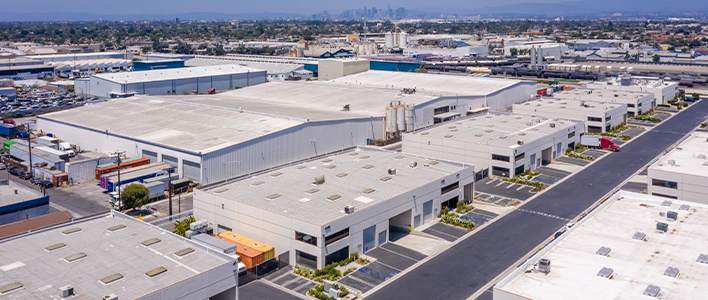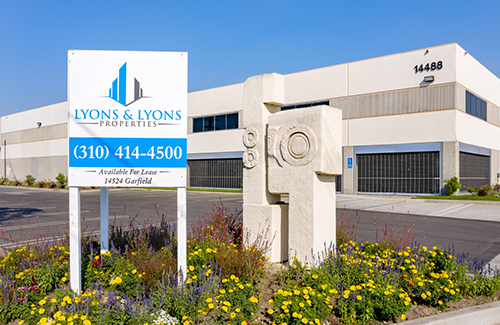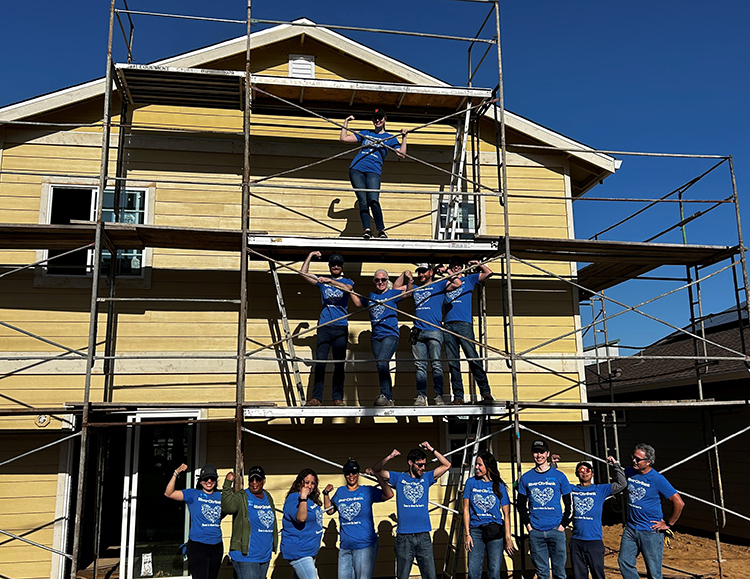By Dan Franklin, Director of Commercial Real Estate, River City Bank

Often operating in the background, the industrial real estate sector is in the midst of monumental shifts.
The pandemic radically changed the way consumers receive goods and services. Increased online ordering and an explosion in data streaming have resulted in increased demand for warehouse space fulfilling retail orders direct to consumers and data storage centers to support streaming services.
At the same time, warehousing and production operations, which for many years functioned based on “just-in-time” delivery models, have shifted toward much larger supply inventories to function in the unpredictable supply chain environment revealed by the pandemic. And logistics providers now need more distribution centers to move goods around. All of this has contributed to a tight industrial real estate market and record-setting growth in rental rates.
Just ask Chuckie Lyons, owner of El Segundo-based real estate development and management company Lyons and Lyons Properties, which manages approximately 70 industrial properties spanning more than 800,000 square feet, all in the Los Angeles region. Although Lyons has been in business for decades, he’s still surprised by the strength of the industrial real estate sector today, particularly in his region, where the aforementioned trends are the most pronounced.
“I’ve never seen rental growth like this,” he told me recently. “I see it as population and internet-driven retail demand, coupled with a limited supply of industrial-zoned land due to decades of cities downzoning their industrial-zoned land to retail and residential.”
Just how hot is this industrial real estate market? Consider that vacancy rates are the lowest in the nation at close to zero, and rents and sale prices have seen double-digit increases over the past several years. Research shows a 19.1% increase in price per square foot year-over-year in Los Angeles County alone, according to a report from CoStar Group.
Properties close to the major West Coast ports like Oakland, Los Angeles, and Long Beach have been primary beneficiaries and have seen the biggest gains. But there are spillover effects for industrial properties outside these core markets, too.
Unprecedented Tight Supply
Lyons established his firm in 1979, right after the 1976 passage of California Proposition 13. He remembers the property tax rate in the city of Los Angeles being 2.7% in the mid-1970s. Prop. 13 cut that rate to 1% – a huge cut to the government property tax base – plus it drastically limited future increases in California property taxes. That led to cities forming redevelopment agencies to incentivize developers to build more retail and residential to increase those cities’ retail sales tax to replace the lost property tax revenue. Since 1976, Lyons estimates there is 25% less industrial-zoned land left in the greater LA/Orange County/Inland Empire area cities, and yet the population there has more than doubled.
This situation isn’t likely to improve anytime soon. In general, new development takes a year or two before it’s ready for occupancy, and given the demand dynamics, any new construction is quickly absorbed. Desirable areas like Southern California lack land that could be developed for industrial use, given zoning laws. And because of the specific physical requirements that industrial tenants have, like necessary space for loading and unloading, it’s hard to retrofit older buildings to meet those demands.
Developers are working hard to increase supply where they can, but most of those new development sites are in the outlying areas such as the eastern Inland Empire. Very few are in the more populated and port-adjacent coastal California areas where there is the most demand.
Insatiable Demand for Space
Demand for industrial real estate started to outpace the available supply well before the pandemic. Call it the “Amazon effect.” The shift toward e-commerce has meant that companies need more warehouse space to accommodate more goods being shipped. COVID-19 accelerated that trend beyond expectations. In the first quarter of 2021, e-commerce sales jumped 46.7% over the year prior and have continued to grow from these elevated levels.
From an industrial real estate standpoint, that means the economy needs more industrial spaces to support this additional online activity, everything from warehouses to distribution centers to data storage, and even flex spaces that can accommodate a range of activities. At the moment, there just isn’t enough supply to meet this surge in demand.

An Overheated Rental Market
Naturally, the tight supply of industrial real estate coupled with huge demand means that rents are rising rapidly, creating an unusual rental market.
“There are last-mile area industrial properties in LA with lease contracts now expiring that were written five years ago. Those leases typically called for fixed rent increases of 3% a year. The current market lease rate in most of those buildings is close to double over the last month’s contract rent of those five-year deals,” Lyons said.
Tenants have responded in a number of ways. For example, some tenants are trying to make commitments to lease space earlier in the process, or they might be leasing more space than they need today as a cushion against future supply constraints. “I’ve also seen current tenants attempting to lock in leases as long as possible well in advance of the expiration of their current leases,” Lyons mentioned.
Landlords have responded with strategies of their own. For example, some are moving away from the industry practice of pre-leasing space that is coming available. Instead, they might try to wait until a building is almost ready for occupancy before setting rental rates in case market rates are higher at the time of delivery.
Lyons also uses different incentives to get tenants to renew leases early. “We sometimes do that to increase our borrowing capacity so that we generate capital to do new deals,” he explained.
But not all landlords are in a position to pass on inflated asset prices to tenants. When purchasing an occupied industrial building, current tenants are already locked into existing leases, typically three to five years, and they may not have the same relationship with tenants to get them to renew early. In those instances, property owners might have to wait until those leases roll over to institute rental rate increases. Will these tenants be willing to pay such elevated rents as their leases roll over, or will they consider moving to smaller markets where they can rent for less?
Near-Perfect Conditions for Appreciation
Rapid rental growth fueled by lack of new supply and incredible demand – coupled with tremendous liquidity remaining in the markets following the enormous federal stimulus during the pandemic – has caused market cap rates in this region to fall 23% over the past year to just 4.15% based on current market rent, according to reports from CoStar Group. And what makes this trend even more impressive is that it occurred during a time when the 10-year Treasury yield essentially doubled from ~1.5% to ~3%. This would normally cause cap rates to rise to allow CRE investors to maintain the same equity risk return premium. The fact that it went the opposite direction suggests industrial real estate investors see minimal downside and a lot of upside potential in industrial rents.
“Everybody is seeing how quickly industrial rents are going up, and there is no vacant industrial land, so they’re betting on that and buying up existing buildings,” Lyons told me.
Other Industrial Markets Also Performing Well

For developers like Lyons who’ve been in the business for many years, the past few years have been very good. The investments they made several decades ago are paying off with higher rents as tenants have fewer choices. Lyons is close to 100% leased for his properties. But it’s a different story for those looking to add to their portfolios. Finding properties that aren’t environmentally challenged or overvalued has become a Herculean task.
As prices continue to soar in preeminent areas of Southern California, smaller markets are starting to see an uptick in demand. The Inland Empire, near Los Angeles County, has been a primary beneficiary. But so, too, have other Western locations like Phoenix and Salt Lake City, which are farther from ports but have more affordable spaces.
Not surprisingly, prices have increased. In the Inland Empire, where absorption rates are low because of a dearth of supply, asking rents more than doubled over the past year and rose 13.7% in the second quarter alone. In Salt Lake City, average asking rents were up 25.5% since the start of the pandemic as of this year’s second quarter as total vacancies dropped and are now hovering at just more than 2%.
Proceed with Caution
The market dynamics driving the frenzy in industrial real estate show no signs of letting up, and industrial investors should have no problem leasing space in the near term.
But a career banker would be remiss to not also call out the risks. The future is always uncertain and trends can reverse, sometimes abruptly and dramatically. A recession induced by inflationary concerns could slow down or reverse these trends, and rising interest rates could materially increase cap rates and, therefore, deflate values.
Many industrial properties being purchased today already have negative operating leverage whereby the cap rate is lower than the interest rate on the debt. Without rental rate growth, this type of investment is destined to be a dog in the portfolio.
Buyers should tread carefully. They’d be prudent to be selective in their tenant mix and build in appropriate rent increases to cover these elevated prices. And when it comes to debt, it’s key to avoid overleveraging in this unique market and consider mitigating interest rate increases, perhaps by financing assets with long-term, fixed-rate debt.
Dan Franklin manages all of River City Bank’s commercial real estate origination activity throughout California and the western United States. Since joining the bank in 2008, Dan has served in various commercial banking roles, including years as Commercial Banking Director, Business Development Officer, and Relationship Manager. A recipient of the Chartered Financial Analyst designation, Dan received his undergraduate and MBA degrees from the University of California at Davis.



